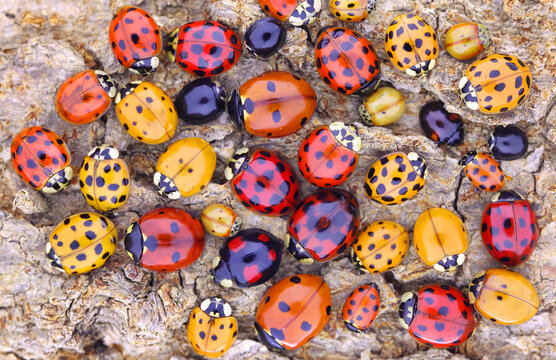Ladybugs, also known as ladybirds or lady beetles, are fascinating little creatures that play a huge role in ecosystems and have a strong presence in human culture. This in-depth article explores everything about these beneficial beetles—from their biology and species diversity to their ecological and cultural importance.

Introduction to Ladybugs
The Life Cycle of Ladybugs
Detailed Overview of Ladybug Species
Table: Common Species, Features, and Conservation Status
Habitats and Adaptations
Ladybugs' Role in Ecosystems
Cultural and Symbolic Meanings
Frequently Asked Questions About Ladybugs
Fun Facts About Ladybugs
Ladybugs, members of the Coccinellidae family, are small beetles known for their bright colors and black spots. Found worldwide, they thrive in diverse environments, from gardens to forests. While their charming appearance often makes them a symbol of good fortune, ladybugs are crucial predators of pests, making them essential allies to gardeners and farmers.
Ladybugs undergo complete metamorphosis in four stages:
Eggs: Females lay clusters of eggs (10-50) on leaves near pest populations like aphids.
Larvae: Emerging larvae look nothing like the adult beetles. These long, spiky creatures are voracious eaters of pests.
Pupa: After weeks of feeding, larvae attach themselves to a surface and transform within a pupal shell.
Adult: Fully grown ladybugs emerge and start feeding and mating to continue the cycle.
The full cycle takes about four to eight weeks, with adult ladybugs often living up to a year.
Ladybugs vary greatly in size, color, and habitat preferences. Below is a table of some common and unique species:
| Common Name | Scientific Name | Color/Features | Habitat | Conservation Status |
|---|---|---|---|---|
| Seven-Spotted Ladybug | Coccinella septempunctata | Red body, 7 black spots | Gardens, fields | Least Concern |
| Asian Lady Beetle | Harmonia axyridis | Orange/red, various spots | Urban, rural areas | Least Concern |
| Eye-Spotted Ladybug | Anatis mali | Red with eye-like spots | Forests | Least Concern |
| Twice-Stabbed Ladybug | Chilocorus stigma | Black with red spots | Trees, shrubs | Least Concern |
| Steelblue Ladybird | Halmus chalybeus | Metallic blue | Subtropical areas | Least Concern |
| Fourteen-Spotted Ladybug | Propylea quatuordecimpunctata | Yellow with black spots | Fields, gardens | Least Concern |
Ladybugs' bright colors serve as a warning to predators, signaling their bitter taste and defensive toxins.
Ladybugs are highly adaptable and found in various ecosystems:
Gardens and Farms: Ladybugs are natural pest controllers, feeding on aphids and mites that threaten crops.
Forests: Some species prefer trees and shrubs, often nesting in leaf litter or bark crevices.
Urban Areas: These beetles thrive in parks and ornamental gardens, often sheltering during winter in homes or attics.
Adaptations include their small, rounded bodies that help them curl up for protection and their ability to secrete a foul-smelling liquid to deter predators.
Ladybugs are indispensable to ecological balance:
Pest Control: Each ladybug can eat thousands of aphids in its lifetime, reducing the need for chemical pesticides.
Biodiversity Support: Ladybugs contribute to the diversity of insects in ecosystems, providing food for birds, frogs, and other animals.
Pollination: While not primary pollinators, their movement between plants aids in pollen transfer.
Their presence ensures healthier plants and sustainable farming practices.
Ladybugs are widely regarded as symbols of good fortune and protection:
European Folklore: Seeing a ladybug is said to bring prosperity and love. In some traditions, making a wish as it flies off ensures good luck.
Eastern Beliefs: In China, ladybugs are considered a sign of joy and protection.
Modern Symbolism: Ladybugs are often associated with childhood innocence, positivity, and nature's beauty.
Their role as gardeners' friends has made them enduring symbols of environmental health and harmony.
Q: Are all ladybugs beneficial?
A: Most species are beneficial, but some, like the invasive Asian lady beetle, can outcompete native species and cause nuisance.
Q: What do ladybugs eat?
A: They primarily eat aphids, but also mealybugs, mites, and small pests. Larvae and adults are equally effective predators.
Q: Can ladybugs bite?
A: Yes, but their bite is harmless to humans, typically felt as a mild pinch.
A ladybug's spots fade with age.
Some ladybugs can overwinter in large clusters of hundreds or thousands.
Their name originated from European farmers who prayed to the Virgin Mary for pest relief, referring to them as "Our Lady's Beetle."
Ladybugs are more than just charming beetles—they're vital to ecosystems and a joy to encounter. From their pest-control prowess to their rich cultural significance, these tiny insects deserve recognition and appreciation. Whether you're observing them in your garden or learning about their unique lifecycle, ladybugs never fail to fascinate.
animal tags: Ladybugs
We created this article in conjunction with AI technology, then made sure it was fact-checked and edited by a Animals Top editor.